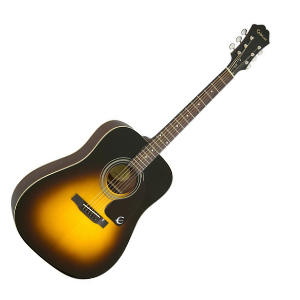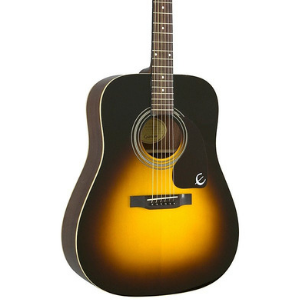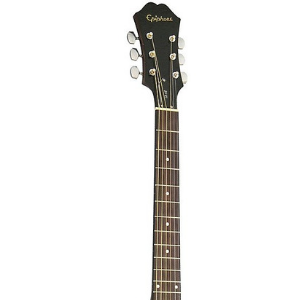- Home
- Instruments
- Gear
- Recording
- Lessons
- Reviews
- Blog


| Body And Neck: |  |
| Hardware: |  |
| Sound: |  |
| Value: |  |
Known for both their electric and acoustic instruments, Epiphone has grown to become one of the world's largest budget guitar manufacturers. Their designs are particularly popular with students and new players looking for an affordable yet high-quality instrument — though more advanced guitarists often appreciate Epiphones for their value and versatility as well.
The Epiphone PR-150, one of the company's most affordable guitars, is a classic dreadnought acoustic that's aimed towards new players looking for an easy guitar to learn on that won't break the bank. For its bargain price, this guitar certainly offers a great package of looks and tone. Let's break down how this stacks up to the competition and examine whether or not this guitar is one of the best acoustic guitars for beginners on the market!
 Body and Neck
Body and NeckEpiphone uses completely laminated wood to construct the PR-150. While solid planks of tonewood will resonate better and produce tones with more depth and substance, laminated guitars make a much more affordable option for beginners on a budget. In the case of the PR-150, you'll find a laminated spruce top along with laminated mahogany for the back and sides.
The neck is made of mahogany to match the body construction, while a rosewood fretboard rounds out the package. It's shaped with Epiphone's SlimTaper profile, though it is still chunkier than many electric guitar necks.
Rather than draw on Gibson's jumbo body shape, the PR-150 uses a Martin-style hard shoulder dreadnought design. This provides a great bass response with plenty of volume and projection even when played softly. It's also a durable shape, which comes in handy for new and inexperienced players who aren't familiar with the intricacies of guitar care. Compared to other manufacturers in this price range, Epiphone's instruments are some of the sturdiest around; they can withstand plenty of damage and keep playing smoothly.

The PR-150 carries Epiphone's full complement of standard chrome hardware. The tuning machines have a 14:1 gear ratio, which is good for making simple and quick adjustments to your strings. Epiphone boasts that the saddle is fashioned from synthetic bone, while the nut is most likely cheap plastic. A black pickguard with a '60s-style “E” logo rounds out the package and adds a bit of flair.
Unfortunately, the string action comes rather high out of the box — this is an easy enough problem to fix by filing down the saddle a bit, but if you don't have any luthier experience, it's best to take it to a professional technician for a full setup.
The dreadnought body shape of this guitar lends it a powerful, upfront voice with loads of presence. It's a great guitar for strummers and players just learning their first couple of chords. If you're a more advanced player, this is also a great beater guitar to take out to campfires or to play around with friends — it's loud enough to play well with a singer and cheap enough that you don't need to worry about damaging it.
Like most budget guitars, the PR-150 isn't the smoothest with single-note lines and fingerstyle playing. It offers a passable tone for many players, but compared to more expensive acoustic guitars, it lacks some depth and style to the notes. For the price, however, it stacks up well against its peers.
The Epiphone PR-150 offers plenty of solid features for its low price. While the tones favor strumming over solos, it's still got plenty of value for beginners and experienced players alike. If you're in the market for an affordable acoustic with good tone that can handle plenty of rough treatment, the PR-150 is one for you to check out.

Reader Interactions